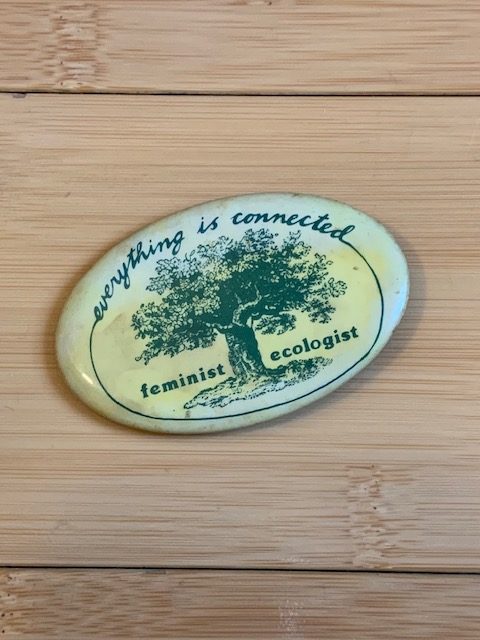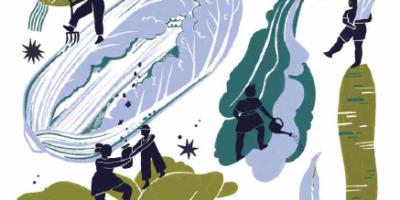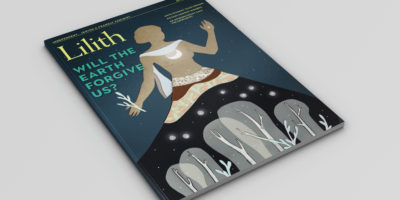
Jewish Ecofeminism through Time
Jewish environmentalism began long before the current climate crisis. According to the Torah, “God said unto Abraham—go out from the land of your father where you now live and go to the land which I will show you.” An ecologically conscious interpretation of this passage links the spiritual and physical worlds, centering the land which sustains us and which we’re required to sustain.
1880s – ALLIANCE COLONY
In 1882, several Jewish families emigrate from Russia to escape pogroms and establish Alliance Colony in New Jersey, the first U.S. farm settlement created solely by Jews. Alliance Colony inhabitants persevere through trying weather conditions to become a vibrant, productive agricultural community.
Soon, more Jewish farming communities spring up across the U.S. Gertrude Dubrovsky, in a 1989 Lilith article, describes her family’s move in 1932 from the Lower East Side of Manhattan to a Jewish farming community, where she watched her mother “raise 2,000 baby chicks by herself.” This story is one of many about women who lead their families to work the land.
1960s – “BACK TO THE LAND”
The U.S. “Back to the Land” movement coming out of the social ferment of the 1960s and 70 is a time of both reconnection with nature and resistance against modern systems of production and consumption. More widespread than before is concern about water and air pollution, as well as disillusionment with the U.S. government following the Vietnam War. Several leaders who are Jewish participate in the movement (including Brooklynite-turned-Vermont homesteader Bernie Sanders and his family). Later, Jewish ecofeminists like Deena Metzger and Susie Orbach become known for their writings on how humans relate to the natural world. Artist Helène Aylon’s observations during this time inspire her 1982 eco-activist project, “Earth Ambulance”.
1980s – ELLEN BERNSTEIN & SHOMREI ADAMAH
In 1988, Ellen Bernstein establishes Shomrei Adamah, America’s first Jewish ecological organization, to educate the Jewish community: “I always believed that Judaism was ecological at its heart, but that the ecological dimensions had been overlooked for centuries,” Bernstein tells Lilith.
Bernstein draws our attention to the language we use to speak about the land. For example, “In Hebrew, the words for land—aretz and adamah—are feminine. The land is generative and brings forth life… [It is] the source of our food, our shelter.” Bernstein calls feminism into play, advocating for a greater appreciation for the land as a living, dynamic entity, which we can’t control, but only steward. As eco-feminist farmer Esther Mandelheim notes in a Lilith special section in 2007, “Eco-Ushpizin: Women Take on the Environment”:“The deep ethical concept from Torah [is] to be a caretaker of the Earth, not an owner.”
Bernstein also cautions that the term “environmentalist” “has become highly politicized and associated with the left only.” She seeks to encourage people of all (and no) political stripes to realize that “the climate crisis is not going away and we need to find activities that will nurture us as we do our best to help nurture the earth.”
2000 – FOOD CONSCIOUSNESS
In the 21st century, many of us now know that the vast majority of food production (and waste) occurs in enormous factories, and that fertilizers and methane used and produced by factory farming are major causes of environmental degradation. Hazon, America’s “largest faith-based environmental organization” since 2000, runs programs to teach food consciousness, sustainability, and environmental organizing, all through a Jewish lens. Isabella Freedman Retreat Center, originally founded in 1893 as a nature camp for girls, is now run by Hazon and provides hands-on ecological education and farming for children and families.
Recent decades have seen more and more information on eating sustainably, along with plenty of cookbooks offering an eco-conscious spin on new and old recipes, plant-based meals, and guidance on local, organic produce. Mollie Katzen, author of the iconic Moosewood Cookbook, tells Lilith in 2008, “It really shouldn’t be about “let’s avoid meat,” but rather “let’s embrace vegetables.” This is where joy, ritual, and celebration come in. “One of the primary messages from Judaism in my life has been that food is a sacred territory,” Katzen says. “If you say a blessing over it, food has to be respected, and you have to slow down and pay attention to it.”
2006 – THE WOMEN’S EARTH ALLIANCE & THE KOHENET HEBREW PRIESTESS INSTITUTE
In 2006, Jewish environmental and social justice activist Melinda Kramer co-creates the Women’s Earth Alliance, with the feminist goal of mentoring ambitious women in the climate space.
WEA’s work is classic intersectional feminism in action: It serves 22 countries with cultural and gender sensitivity. Its leadership is decentralized and diverse, and team members work to provide communities with what they need most, from water access to forest conservation. A valuable lesson the WEA teaches is that environmental crises hit marginalized communities hardest—and the work to restore environmental health and safety looks different in different places.
Also in 2006, Rabbi Jill Hammer and Talya Shere co-found the Kohenet Hebrew Priestess Institute, an inclusive and diverse space dedicated to women-led and women-centered spiritual training. Much of Kohenet ideology and practice is mindful of the natural world, indigenous justice, and the interactions between the environment, Judaism, and feminism—according to Executive Director Keshira haLev Fife, the Kohenet movement comes at a time when “liberal Jewish communities in particular are increasingly seeking the kind of earth-based “Jew witchery” [that] institute graduates offer.”
2007 – A SABBATICAL FOR THE LAND Shmita is the Torah-mandated practice of letting the land “lie fallow” for the final year in each seven-year agricultural cycle, one of the strongest biblical calls for ecological consciousness.
The Shmita Project, founded in 2007, offers lessons in sustainability and social justice, including “rest and work, relationship to land, relationship to community, relationship to debt and debt relief, definitions of community, and the issue of consumption itself.” The next Shmita year begins September 6th, 2021.
2010 – SOULFIRE FARM AND RACIAL JUSTICE
In 2010, Leah Penniman, an educator, activist, and Black farmer who is a part of a Jewish family, co-founds Soulfire Farm in Petersburg, New York, to “reclaim our inherent right to belong to the earth” as well as to “have agency in the food system as Black and Brown people.”
Systems of oppression sustain each other, which is why it is logical (and necessary) to fight racism and “food apartheid” in tandem. The farm offers programs to teach farming skills to women of color, advocate for food security and land justice, and more.
2016 – ZERO HOUR AND YOUTH ACTIVISM
One of numerous new and radical youth-led efforts to combat climate change is Zero Hour, co-founded by Jamie Margolin in 2016. The organization engages in campaigns to educate and advocate for climate justice legislation, such as the Green New Deal. These campaigns connect environmental injustice to other oppressions with the urgency felt by youth who see their future melting away.
2017 – INDIGENOUS JUSTICE & REFRAMING OUR MINDSET
From 2016–2017, protests against the Dakota Access Pipeline at Standing Rock
Reservation made clearer than ever the confluence of Indigenous and environmental justice. In her 2017 novel, A Rain of Night Birds, Deena Metzger examines what we can learn from these protests, as well as from long-standing Indigenous traditions that feature respect for and stewardship of the natural world. In an interview with Allison Rose Levy, Metzger says, “[Indigenous peoples] have maintained a way of seeing, a way of understanding, that was assaulted from the beginning of…colonialism. And so, what Standing Rock also offers, and insists upon, is self-scrutiny by…the non-indigenous culture that has taken over this land.”
2019 – DAYENU, A JEWISH CALL TO CLIMATE ACTION FOUNDED BY RABBI JENNIE ROSENN
In 2019, Rabbi Jennie Rosenn creates Dayenu, “a Jewish call to climate action” as a tool to help the Jewish community unite, and join with other communities to confront the climate crisis “with spiritual audacity and bold political action.” Despite her initial hesitance to start the organization, Rabbi Rosenn acknowledges her responsibility to fight for climate justice and encourage others to do so as well. “The impacts of the climate crisis rest disproportionately on people living in the global South, in poverty, in particularly vulnerable areas, and people who experience racism and other kinds of bigotry,” She tells Lilith. But Rabbi Rosenn further notes, “Women are also in a powerful position to…build greater resiliency in response to a changing climate. And of course, many of the most powerful climate movements across the world are being led by women. Now as we create Dayenu, I am working to bring feminism into the organization’s DNA.”
Key to Dayenu’s work is a focus on the systemic origins of the climate crisis. Rabbi Rosenn urges us to focus not on “what car do I buy?” but “what cars does Detroit manufacture?” Not just “where do I bank?” but “what are the biggest banks in the world investing in fossil fuel and how do we take action on them?” “We need to think big,” she says. “We need to take collective action at the scale the science and justice demand.”
2020 – LIZ DILLER ON REIMAGINING URBAN SPACES
In a 2020 TED Talk, queer Jewish architect and designer Liz Diller explores the problem of privatized urban space. In 2004, Diller, along with activists and designers, created The High Line, a 1.45-mile-long elevated public green space along an abandoned railroad track in New York City. As the project began, she recalls, “We fell in love with the accidental ecosystem that developed there after years of neglect. Rather than making architecture, we vowed to protect this place from architecture.”
The High Line has become a New York hotspot, rich with plant life and public art. However, she laments, “The park inadvertently fell victim to its own success and became an agent of rapid urbanization.” And so she advocates for “a democratic public realm so that dwindling urban space is not forfeited to the highest bidder.”



